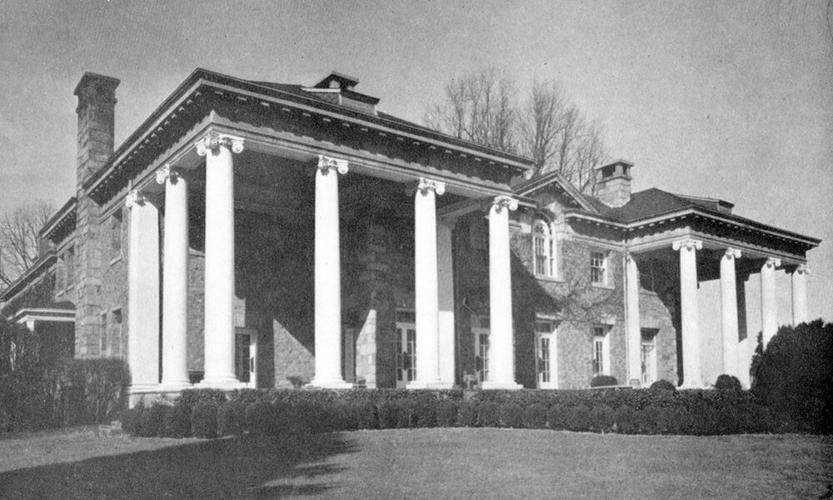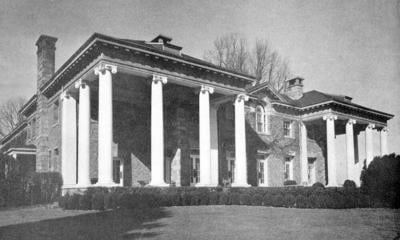The Crosby Estate near Warrenton
The unique name “View Tree” has been part of Fauquier County history for years, originally applied to an ancient chestnut tree that once stood near the top of Watery Mountain, just West of Warrenton.
Legend has it that on a clear day, observers could see Washington, D.C. from the View Tree, making it a useful observation post for both sides during the Civil War.
In later years the tree was gone, and near the site replaced in 1906 with a beautiful 24-room Gothic residence built by Oscar Terry Crosby (1861-1947). View Tree Farm would remain in the Crosby family until late 1950, when the property was acquired by the U.S. Government.
In the more than four decades that the Crosby family lived at View Tree, they had a significant, positive effect on the community. Oscar Terry Crosby was married to Jeanne Bouligny (1864-1934), sister of Mlle. Lea Bouligny (1865-1954), later the founder and headmistress of the Warrenton Country School. The couple had four daughters, Elizabeth (1894-1908), Juliette (1895-1969), Miriam (1896-1966) and Celeste (1900-1967).
The Crosbys were frequent summer visitors of Mrs. Thomas Semmes – a fellow New Orleans native who lived on Culpeper Street – and leased properties in Warrenton before deciding to relocate here.
In 1904, they purchased the 358-acre property on Watery Mountain from Ann M. Payne, the widow of A. D. Payne, for $8,797. Construction of their new home started soon afterward.

Map of the Watery Mountain property purchased by the Crosbys from Mrs. A. D. Payne in 1904 shows property lines and adjacent owners. The 4-acre square exclusion at lower right corner was the Warrenton Reservoir.
Miss M. Louise Evans (1887-1966), whose family came to Warrenton about the same time as the Crosbys, became a close friend of the family. She worked as a typist/ stenographer for Mr. Crosby in an office above the old Post Office, working on the text for his several books. “His dictation was probably the most erudite I ever took,” she recalled in an article in The Fauquier Democrat in 1950.
A showplace, the mansion at View Tree was the scene of many distinguished formal and informal gatherings of diplomats, ambassadors and fellow explorers with whom Crosby had worked over the years. But the Crosby family was well-known and respected in their adopted town and county as well.
“They were excellent citizens, active in civic undertakings, the Red Cross, and numerous charities,” recalled Miss Evans. “They entertained local friends and guests generously, opening their home for numerous events and on many occasions.”

The ‘view tree’ once stood on Watery Mountain west of Warrenton.
After the family had been at View Tree for less than two years, the Crosbys were struck by a great tragedy. In July 1908, eldest daughter Elizabeth, 14, drowned in the town reservoir on View Tree.
It is notable that the Town of Warrenton Reservoir on the property figured prominently in the Great Fire of 1909. Because of the drought and a leak in the dam, water pressure to fight the fire was negligible, then non-existent. The town was saved by heroic efforts and the blasting of structures in the line of the fire, creating breaks.
The next three decades saw Oscar Terry’s achievements in business, government service and world-wide exploration and writing continue, and one-by-one, the Crosby daughters married and moved away.
After a brilliant social life, Miriam married Count Mario Carracciola di Melito, an Italian career diplomat, whom she accompanied on various posts in Europe before World War II, at which point she returned to View Tree.
An artist and actress, Juliette had a successful theatrical career, and in 1923 married Arthur Hornblow Jr., a well-known theatrical critic and producer. With her knowledge of languages, Celeste, who married Ralph G. Miller in 1929, enjoyed a number of important and interesting appointments as an interpreter, including one with the U. S. State Department to the organization meeting of the United Nations.
With the death of their father the year before, Celeste and Juliette came back to Warrenton and put View Tree up for sale in 1948, while it was thought that a private buyer who might have come there in the past might be interested.
But in December 1950, the U.S. Government that bought View Tree from the Crosby sisters for $114,950 and Mlle. Bouligny’s Warrenton Country School for $170,000. The properties were immediately converted for classified operations as Station A and Station B of the Warrenton Training Center, as they continue today.
“Thus the View Tree Estate passes to others,” wrote Miss Evans about the sale in 1950. “But each of the Crosbys leaves us with a void in the hearts of our community, and the many that have loved the place as the Crosby home, and loved the Crosbys because they were the Crosbys, and were lovable.”
In a sense they are still here, as Mr. and Mrs. Crosby, daughters Elizabeth, Celeste and Juliette and Mlle. Bouligny chose the Warrenton Cemetery as their final resting place.
Oscar Terry Crosby, Renaissance man
The patriarch of the Crosby family was Oscar Terry Crosby (1861-1947), a native of Louisiana who had a distinguished career as an industrialist, federal government executive, explorer and author. An 1882 West Point graduate with a degree in Electrical Engineering, he served in the U.S. Army Corps of Engineers.

OSCAR TERRY CROSBY, 1861-1947
Returning to civilian life in 1887, Crosby was a superintendent of the Sprague Electric Railway and Motor Co., and later general manager of the railway department of the General Electric Co. From there, he headed utility companies in Washington, D.C., Chester, Pa. and Wilmington, Del., ultimately founding the Potomac Electric Co. (PEPCO).
Books he authored during this time were The Electric Railway in Theory and Practice (1892), and Strikes: When to Strike and How (1910).
Crosby was also an explorer, having gone to parts of Abyssinia (Ethiopia) and Sudan in 1900; on expeditions to Turkestan and Tibet in 1903; and to Borneo in 1915. Books he authored during this time included Tibet and Turkestan: A Journey Through Old Lands and A Study of New Conditions (1905).
Based on his writings and explorations, he was made a fellow of the Royal Geographic Society of London, and a commander of the French Legion of Honor.
Crosby was appointed director of Belgium relief under Herbert Hoover in 1915, and two years later appointed assistant secretary of the treasury in the Wilson administration. From 1917- 1919, Crosby served in Europe was president of the Inter-Allied Council on War Purchases and Finance, where he was in charge of U.S. loans to Allied powers during World War I. For his efforts he was awarded both the Belgian and Italian Orders of the Crown. Based on his experiences, he published International War: Its Causes and Its Cure in 1919.
Well into his 60s, Crosby continued his explorations, going to Southwest Africa in 1927, Tanganyika, Kenya, and the Belgian Congo in 1936 and to Romania, Russia, Poland, and Germany in 1937.
Finally retired, Crosby spent his final years at View Tree, where he died on Jan. 22, 1947.






(0) comments
Welcome to the discussion.
Log In
Keep it Clean. Please avoid obscene, vulgar, lewd, racist or sexually-oriented language.
PLEASE TURN OFF YOUR CAPS LOCK.
Don't Threaten. Threats of harming another person will not be tolerated.
Be Truthful. Don't knowingly lie about anyone or anything.
Be Nice. No racism, sexism or any sort of -ism that is degrading to another person.
Be Proactive. Use the 'Report' link on each comment to let us know of abusive posts.
Share with Us. We'd love to hear eyewitness accounts, the history behind an article.